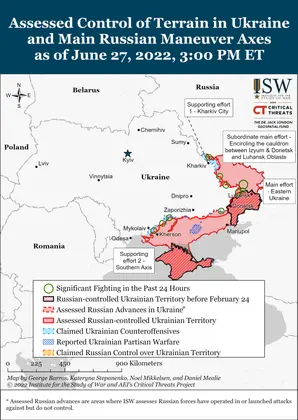Key Takeaways:
- Russian forces struck a shopping mall in Kremenchuk as part of a recent escalation in strikes against Ukrainian infrastructure and cities.
- Russian forces made incremental advances southwest of Lysychansk near the T1302 Bakhmut-Lysychansk highway but have not entirely severed Ukrainian lines of communication into Bakhmut.
- Russian forces made measured advances during offensive operations to the east of Bakhmut.
- Ukrainian forces repelled Russian offensives north of Slovyansk.
- Russian forces made limited and localized attacks along contested frontlines around Kharkiv City but did not make any advances on June 27.
- Ukrainian counteroffensives along the Southern Axis continue to force Russian troops to prioritize defensive operations along the line of contact.
- Russian occupation authorities are taking steps to strengthen economic control of occupied territories and force Ukrainian civilians to switch to the ruble.
A Russian missile strike hit a shopping mall in a residential area of Kremenchuk, Poltava Oblast on June 27, likely killing many civilians.
JOIN US ON TELEGRAM
Follow our coverage of the war on the @Kyivpost_official.
Ukrainian sources stated that over 1,000 civilians were inside the mall at the time of the strike, and officials are still clarifying the number of casualties.
The Kremenchuk strike follows a wider intensification of Russian missile strikes against Ukrainian infrastructure and civilian targets in recent days. Advisor to the Ukrainian Ministry of Internal Affairs Vadym Denisenko stated on June 26 that Russian forces have begun a campaign of massive and largely indiscriminate missile strikes against Ukrainian cities, which echoes statements made by an unnamed US defense official on June 27 that Russian forces are increasingly relying on artillery and missile strikes to advance operations in Ukraine.
As Russian forces continue to burn through their supply of high-precision weaponry, such attacks that cause substantial collateral civilian damage will likely escalate.
Russian military authorities continue to seek ways to replenish their increasingly exhausted force capabilities without announcing general mobilization.
An unnamed senior US defense official stated on June 27 that Russian forces are likely running low on senior military leaders and are relying more heavily on retired officers and reserves to replace officer casualties. The UK Ministry of Defense similarly reported that Russian forces will likely rely heavily on reserve echelons, namely the Combat Army Reserve (BARS) and Human Mobilization Resource, in order to galvanize volunteer support and fill out the third battalion tactical group (BTG) within regular (and depleted) brigades.[6] As ISW has previously assessed, such reserves are unlikely to provide Russian forces with meaningful regeneration of force capabilities.
Authors: Kateryna Stepanenko, Karolina Hird, Mason Clark, George Barros and Grace Mappes
Read the full report here.
You can also highlight the text and press Ctrl + Enter



